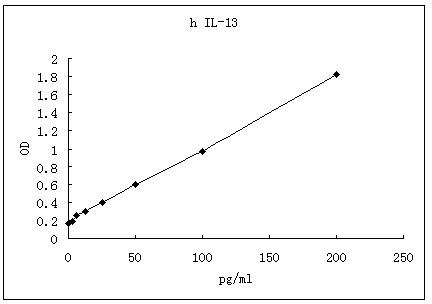Human IL-13 ELISA Kit (48-well)
CNY 2,890.00
Specifications
| Product Data | |
| Description | Human IL-13 ELISA Kit (48-well) |
| Size | 1 x 48 wells |
| Format | 48-well strip plate |
| Assay Type | Solid Phase Sandwich ELISA |
| Assay Length | 3 hours |
| Signal | Colorimetric |
| Curve Range | 3.125-200pg/ml |
| Sample Type | Cell culture supernatant, serum, plasma (EDTA, citrate, heparin) |
| Sample Volume | 20 uL |
| Specificity | Natural and recombinant Human IL-13 Ligand |
| Sensitivity | 1pg/mL |
| Reactivity | Human |
| Interference | No significant interference observed with available related molecules. |
| Components |
|
| Background | Interleukin-13 (IL-13) is a 17 kDa immunoregulatory cytokine that plays a key role in the pathogenesis of allergy, cancer, and tissue fibrosis . It is secreted by Th1, Th2, Th17, NK, and mast cells, visceral smooth muscle cells, eosinophils, and basophils . This pattern is similar to the expression of Interleukin-4 (IL-4) but also includes subsets of Th1 and Th17 cells that do not secrete IL-4 . IL-13 circulates as a monomer and has two internal disulfide bonds that contribute to its bundled four .-helix configuration . Mature human IL-13 shares approximately 58% amino acid sequence identity with mouse and rat IL-13. Despite the low homology, it exhibits cross-species activity between human, mouse, and rat . IL-13 suppresses the production of proinflammatory cytokines and other cytotoxic substances by macrophages, fibroblasts, and endothelial cells. On B cells, it promotes cellular activation, immunoglobulin class switching to IgE, and the upregulation of CD23/Fc. RII. Polymorphisms and upregulation of IL-13 are associated with atopy, asthma, airway hyperresponsiveness, and tissue fibrosis . The biological effects of IL-13 and IL-4 are closely related due in part to a shared receptor system. IL-13 binds with low affinity to the transmembrane IL-13 R.1 which then forms a signaling complex with the transmembrane IL-4 R. . This high affinity receptor complex also functions as the type 2 IL-4 receptor . Soluble forms of IL-4 R. are expressed which retain ligand binding properties and inhibit IL-4 bioactivity . IL-4 R. also associates with the common gamma chain (.c) to form the type 1 IL-4 receptor complex . Additionally, IL-13 binds with high affinity to IL-13 R.2 which is expressed as cell surface and soluble forms . IL-13 R.2 functions as a decoy receptor by preventing IL-13 from signaling through the IL-13 R.1/IL-4 R. complex . It also inhibits responsiveness to IL-4 by blocking signaling through IL-4-occupied IL-13 R.1/IL-4 R. receptor complexes . IL-13 R.2 is upregulated during Th2-biased immune responses and limits inflammatory tissue damage . Aside from its decoy function, IL-13 R.2 can signal in response to IL-13 to directly promote tumor cell invasiveness and the development of tissue fibrosis . |
| Gene Symbol | IL13 |
| Standard Curve |

Representative standard curve for IL-13 ELISA. IL-13 was diluted in serial two-fold steps in Sample Diluent.
|
Documents
| Product Manuals |


 United States
United States
 Germany
Germany
 Japan
Japan
 United Kingdom
United Kingdom
 China
China

